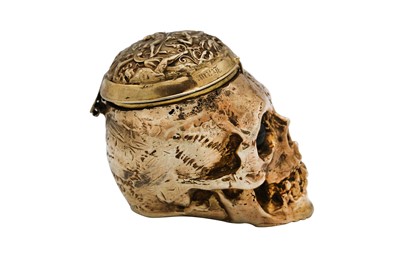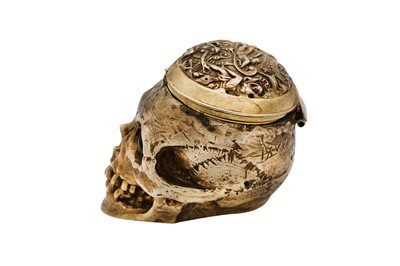9th Nov, 2021 12:00
Watches
MEMENTO MORI SKULL POCKET WATCH
R & G BEESLEY.
A parcel-gilt silver Memento Mori skull pocket watch, R & G Beesley, Liverpool, England, second half 19th century
The case: cast in solid silver and gilt, in the shape of a human skull, naturalistically rendered, the eyes filled with dark red resin beads, the back impressed with a copyright mark ©followed by J.H. 1990, further undecipherable characters and the inscription Naver (?), marked in Roman numerals IXVVIII (958, 95.8% purity of silver), the top hinged lid loose and a likely later match, chased with a naked man reclining on a bed in the centre of the scene, holding a large sickle, another symbol of death, surrounded by another naked man and women, possibly a bacchanalian scene or a mythological scene from the underworld, engraved on the rim with an old English font and reading Kama (?), opening vertically, 5.5cm x 4cm x 6.2cm.
Fuse movement 19th century with 4 Jewels, , floral motifs over the balance, fine regulator, patented, No.13723
Since the beginning of time, skulls have been featured in craftsmen’s creations and artworks as a constant reminder of our mortality and finite nature, the ultimate Memento Mori. This trope finds its roots in the philosophers of classical antiquity and Christianity, and from the Medieval period onwards, it becomes a Leitmotiv in Western funerary art and architecture. The motif remains particularly rooted in the visual arts throughout the Middle Ages and Renaissance, leading to creations like the Danse Macabre and the renowned genre of 16th and 17th-centuries paintings called vanitas, focusing on ephemerality, the transience of life, the futility of pleasure, and the certainty of death.
The Memento Mori motif was introduced in wearable accessories as a form of mourning jewellery as early as the 14th century, and it soon became a personal philosophical statement. Indeed, the constant reminder of death was not meant to be depressing, but rather encourage the wearer to treasure and cherish their life on earth more. From jewellery, the motif entered the world of timepieces; what better way to remind someone that their time is finite, if not a watch?
In the 19th and 20th centuries, memento mori pieces became highly collectable and sought-after: when earlier examples were not available, collectors specifically commissioned them and had them designed to fit the purpose. A brilliant example of this fashion can be appreciated in the collection of Pierre Bergé sold at Sotheby’s Paris on the 30th of October 2018 (please see lots 49 to 77, and especially lot 59, being a silver memento mori pocket watch).
We are thrilled to present three memento mori pocket watches in our November Watches sales, all dating to the 19th and 20thcenturies and fitted with important watchmakers’ movements, treasured by a private English collector and offered for the first time at auction.
Do you have an item similar to the item above? If so please click the link below to submit a free online valuation request through our website.






